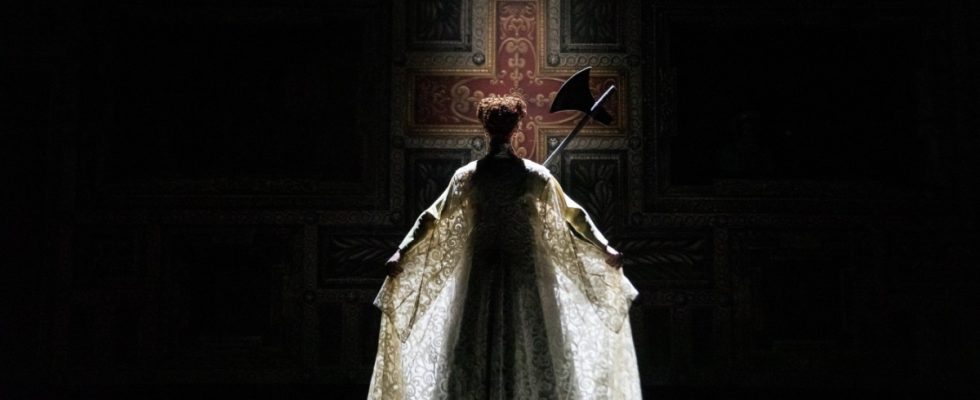Reddish shimmering hair, delicate shoulders under glistening brocade, the royal back trembles in the limelight: That’s how she stands there, England’s monarch Elisabeth, and the executioner’s ax moves like a metronome set to slow motion in front of her face. Right, left, right, left. Should she, shouldn’t she? Signing the death warrant against Mary Stuart would mean: the queen would have her own kind executed. Even more: an aunt your own niece (at least according to the historical genealogy). Soon she will be celebrating in the midst of the royal household, mercifully putting off the marriage proposal of a French prince like everyone else, applauding a troupe of jugglers. However, a ghost has long nested in her head: at every step she sees herself being followed by Maria – a blood-related creature in the shadows, alter ego. Erasing it is self-extinguishing. And it’s still unavoidable.
The duel between Elizabeth I and Mary, Queen of Scots, which ended with the execution of the Scots Queen in 1587, has been the subject of numerous and varied theatre, opera and film theatres. Aside from Martha Graham, who choreographed the story as a tennis match in 1985, the dance has pretty much ignored the royal feud. Now Bridget Breiner, director of the Baden State Ballet, is taking advantage of the “Game of Thrones” hype and bringing the early modern battle for the throne to the stage of the Karlsruhe State Theater. In the fourth attempt, the world premiere, which was postponed several times due to the corona virus and was based on Friedrich Schiller’s tragedy, has now succeeded. The relief is written all over Breiner’s face during the final applause, and the audience showers her with ovations. An ambitious project is being celebrated, which brings together the actually fabulous ballet company with the actually no less fabulous opera choir of the house.
The private feud between two rivals is shown, not a political thriller
Nevertheless, this combination proves to be a staging brake. What has to do with a clash of cultures: Instead of merging, the rigidly planted ladies and gentlemen from the music department and the quicksilver corps de ballet guard their respective claims. So the aristocratic sisters’ war remains a conflict against a pale social background: nowhere a political color. Even the historicizing noble couture and the sparsely furnished stage design by Jürgen Franz Kirner change nothing.
On the other hand, what happens between two or three actors in chamber play-like scenes, Breiner succeeds brilliantly. The ex-ballerina, who previously made Gelsenkirchen a hotspot of contemporary dance, once again proves her talent for expressive relationship management. Breiner knows how to use the classical ballet idiom as a contemporary communication tool. For example, when the queens meet in the garden of Fotheringhay, which Schiller, contrary to historical facts, conceived as the climax and turning point of the drama. Breiner also has a showdown between the rivals: from the depths of the room, Sophie Martin approaches as Elisabeth in yellow trousers, the blue robe of her opponent (Bridgett Zehr) shines at her from the edge of the stage. The women stand face to face, slide to the ground, lie on their stomachs, fixate on each other like archaic sphinxes. They are already on their knees, painting synchronous and mirror-inverted gestures in the air, stretching their fingers imploringly towards the sky. As if God – the Protestant Elizabeths, the Catholic Marias – might bear witness to their conflicting truths. Not only the colors of their clothes, but also their souls are complementary: one has what the other lacks. As friends, they would be unbeatable. Enemies, they are pure poison for each other and the world.
Elizabeth’s Catholic rival: Mary Stuart (Bridgett Zehr), Queen of Scots.
(Photo: Yan Revazov)
Bridget Breiner, who took office in Karlsruhe at the same time as the Corona outbreak, is the only woman to lead a West German company of this size. In view of the numerous dancers who work at the more than sixty city and state theaters, this is an indictment. But it fits into the image of the US Dance Data Project has just been determined: According to this, the number of female executives has recently shrunk again worldwide. It is all the more important that women are given a chance in the executive floors and, conversely, that they have the confidence to take on the managerial role. Just as did the two power rivals in northern Europe, with Mary victorious overall: her descendants still rule Britain to this day, while the Tudor lineage died out with Elizabeth’s death in 1603.
Some things look old-fashioned, but the key scenes are perfect
Breiner’s ballet, meanwhile, sticks firmly to the historical passe-partout. Which has the disadvantage that some things seem slightly old-fashioned. The goofling of the men at court, the boudoir-like atmosphere in Maria’s office – despite Christ on the cross – plus the affected gallantry of the French embassy – all of this could easily have come from a libretto from the end of the 20th century. The music selection, which mixes Benjamin Britten’s “War Requiem” with contemporary compositions by James MacMillan, also sounds strangely dull. Not only is Schiller’s dramaturgy reduced from five to two acts, the pathos also appears dimly dimmed in places.
The key scenes are perfect for that. As soon as the operationally blind, self-overestimating Leceister (Ledian Soto) first ensnares Elisabeth, then Maria, or State Secretary Gavison is struggling with Elisabeth to sign the death sentence, Breiner pulls out everything that the art of the pas de deux has to offer: intricate elevations, filigree arabesques and colliding glances that ensnare the audience eye as the third party. The ending is also strong when Maria climbs the place of execution with a blood-red train and comforts the executioner before he completes his deadly work. In such moments, Bridget Breiner shows her heroines in close-up. More of that and the two-and-a-half-hour double portrait would be a sensation.

